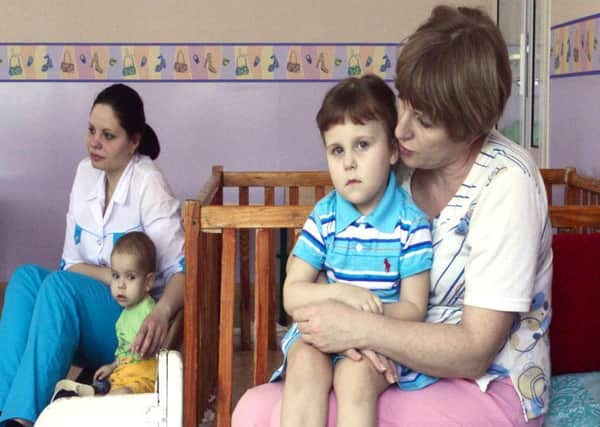Orphans pay price as battle rages in Ukrainian city


The orphanage is on the Ukrainian side of the war in east Ukraine, but this hasn’t always been the case. Russian-backed separatists took the area last summer, wreaking havoc in the process.
All of the children at the orphanage are under four years old, and many of them have special needs and severe physical disabilities, making any evacuation process particularly difficult. The four-storey building acts as a school, home and hospital for the children. On the top floor, the 32 most fragile children are cared for – their small fragile bodies are riddled with tubes and wires, 29 of the children have Aids.
Advertisement
Hide AdAdvertisement
Hide AdThe war in East Ukraine has claimed more than 6,000 lives in the past year. Pro-Russian separatists have looked to form an autonomous area in East Ukraine and forge close ties with Russia. The political move has been met by violence on both sides, with the Ukrainian government claiming that separatist actions are terrorist acts against the state.
When separatists took Kramatorsk last year, mortars aimed at the nearby airfield flew directly over the orphanage. The noise of artillery fire and rocket explosions reverberated around the buildings with frightening frequency.
“Now the children know what shelling means, they know what shooting and bombing means,” Romanov said. “They were always screaming for their mothers when the bombing went on, and even now they have nightmares.”
As the conflict raged outside the orphanage’s walls, Romanov struggled to find a way to move the children. His staff, he says, were terrified but refused to flee. The orphanage remained full while the buildings nearby quickly emptied of residents as the war descended on Kramatorsk.
The orphanage suddenly found itself in a desolate war zone, filled with tanks and weapon-clad soldiers – the children, unable to be moved easily because of their severe disabilities, were stranded in between
Filippa Nazerenko, one of the head nurses, started to put together a plan to help protect the orphanage and the stranded children. Despite admitting that she was terrified of being killed in the crossfire, Nazerenko and other staff members painted banners with the words “SOS Do not shoot the children” and “This is a territory of peace.” Nazerenko, venturing outside as the fighting raged around, collected children’s toys and lined them up around the extensive walls of the orphanage to stop separatist fighters from targeting the building, or using it as a base while fighting the Ukrainian army.
The plan worked. Eventually an agreement was reached by both sides to allow safe passage – the children were haphazardly, but safely, evacuated in buses to the Ukrainian city of Kharkiv, well away from the front lines. However, when the separatists were pushed out of the area, the children were moved back to Kramatorsk, despite the looming threat of fighting.
Romanov is convinced he hasn’t seen the last of the conflict in Kramatorsk, “but we are more ready than ever,” he says. A complex evacuation plan is now in place, and rooms have been sorted into makeshift bunkers and bomb shelters.
Advertisement
Hide AdAdvertisement
Hide AdRomanov showed Scotland on Sunday the most fortified room at the orphanage, where 150 small mats line the walls. The room has been designed as the last stop before evacuating underground to the bomb shelter which lies outside in the grounds, several metres from the room.
Nazerenko is worried about what the future holds – but she is adamant that she will not abandon the orphanage.